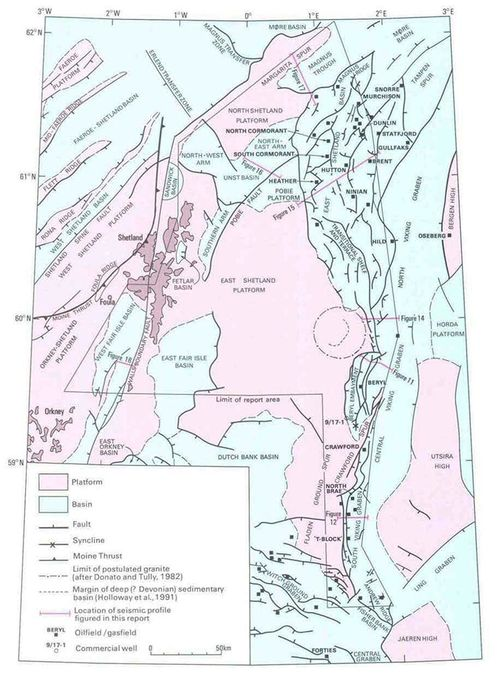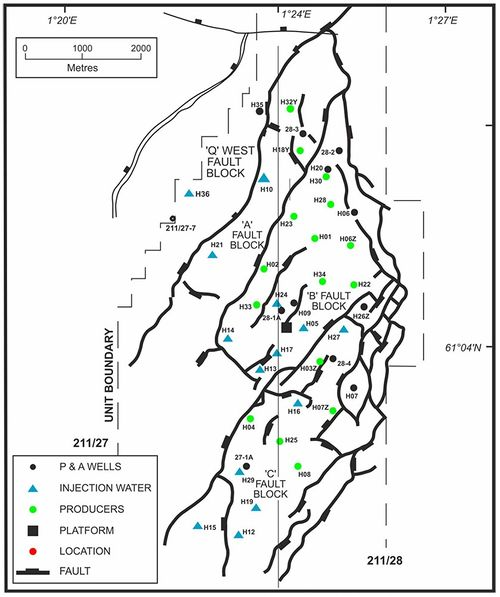OR/19/034 The Hutton Field
| Fellgett, M W, Kingdon, A, Fernie, A, Baker, G, Mehta, M, Henderson, A F. 2019. Oilfield in a box: The Hutton Field dataset. British Geological Survey Internal Report, OR/19/034. |
The Hutton Field is located in the East Shetland Basin in Quadrant 211 to the west of the North Viking Graben in the UK Northern North Sea (Figure 1). It is approximately 480 km NE of Aberdeen and extends across blocks 211/28 and 211/27; it was discovered by Conoco well 211/28–1a in 1973 (Haig, 1991[1]).


The field measures approximately 9 km north to south and 3 km east to west (Haig, 1991[1]). A series of three tilted fault blocks (A, B, and C), downthrown to the northwest, make up the main structure (Figure 3).

Field structure and stratigraphy
The East Shetland Basin formed as a result of Mesozoic rifting, although the precise structural evolution is still debated (Johnson et al., 1993[2]). The most likely model consists of two phases of rifting; initially in the late Permian/early Triassic, followed by another phase of rifting in the late Jurassic (Johnson et al., 1993[2]). However, sedimentation in the basin continued through the Mesozoic and Cenozoic with up to 11 km of syn and post-rift sediments present (Haig, 1991[1]; Johnson et al., 1993[2]).
The East Shetland Basin comprises of a series of north north east to north-east trending tilted fault blocks that downthrow towards the Viking Graben in the east (Figure 2) (Johnson et al., 1993[2]; Zanella & Coward, 2003[3]). The Hutton field lies in the western of the two main north-trending blocks (Figure 2) (Johnson et al., 1993[2]). The faults with the largest offsets in the East Shetland basin have a northerly tend and are downthrown to the east (Johnson et al., 1993[2]). However, as shown in Figure 3, the faults in the Hutton field have a NE trend, which is a result of more variable fault block tilt direction (Johnson 1993[2]). The majority of the Hutton field sits in quad block 211/28 and a summarised stratigraphy from the Triassic to the present is shown in Figure 4.
The Jurassic age Brent Group is the main reservoir unit in the Hutton field and the Kimmeridge Clay Formation is the source rock (Haig 1991[1]). The Brent Group conformably overlies the Toarcian to Aalenian age Drake Formation of the Dunlin Group in the East Shetland Basin, however, local unconformities have been observed (Johnson et al., 1993[2]; Richards et al., 1993[4]). The Bathonian to Oxfordian Heather Formation of the Humber Group conformably overlies the Brent Group, however local unconformities have been observed (Richards, 1992[5]; 1993[4]).
The Brent Group is comprised of five Formations. These are, in order of oldest to youngest: the Broom Formation; Rannoch Formation, Etive Formation, Ness Formation and Tarbert Formation (Richards et al., 1993[4]). The group consists of both coastal and marine sediments and was deposited in a regressive-transgressive deltaic system (Richards et al., 1993[4]). As a result, the Brent Group can be laterally heterogeneous with Formation characteristics varying, particularly on wireline logs. The main stratigraphic units in the Quad Block 211/28 are referred to using a scheme after Bowen (1975)[6]. The relationship between Bowen (1975)[6] and the Brent Group Formations are shown in Table 1.
| Formation | Unit Name (Bowen 1975) | |
Brent Group |
The Tarbert Formation | Upper sand unit |
| The Ness Formation | The Delta plain sediments of the Middle Shaly Unit | |
| The Etive Formation | The Massive Sand Unit | |
| The Etive/Rannoch Formation | The Massive/Mica Sand Unit | |
| The Rannoch Formation | The Mica Sand Unit | |
| The Broom Formation | The Basal Sand Unit |

211/28 Main reservoir units
This section contains a brief description of the main reservoir units in Quad Block 211/28 based on Haig (1991)[1], Johnson et al. (1993[2]; 2005[7]) and Richards et al. (1993)[4].
Broom formation
The Broom Formation typically consists of well sorted medium to coarse-grained sandstone with large scale planar cross-beds and shallow marine burrows in the East Shetland Basin (Richards, 1992[5]; Johnson et al., 1993[2]). The Aalenian age Broom Formation has been interpreted to have deposited in a range of depositional settings ranging from a transgressive tidal-flat to fan-delta setting (Richards et al., 1993[4]; Johnson et al., 1993[2]). In the Hutton field, the formation is described as a laterally continuous series of medium-to coarse-grained sandstones with common mud clasts (Haig, 1991[1]). The average thickness is 12.2 m (40 feet) (Haig, 1991[1]).
Rannoch formation
The late Aalenian to early Bajocian Rannoch Formation typically consists of an upwards coarsening section of mudstones to fine grained sandstones (Johnson et al., 1993[2]; Richards et al., 1993[4]). The Rannoch Formation is interpreted to have been deposited in a storm-influenced shoreface setting (Johnson et al., 1993[2]) and in progressively shallow water on the middle to lower shoreface of a delta front (Haig, 1991[1]). In the Hutton field, the average thickness of the Rannoch Formation is 13.7 m (45 feet), comprised of fine grained micaceous siltstones and sandstones (Haig, 1991[1]).
Etive formation
The late Aalenian to early Bajocian Etive Formation typically consists either of massive upward coarsening sandstones, or an upward fining sandstone unit (or units) with a sharp base (Johnson et al., 1993[2]; Richards et al., 1993[4]). Deposition of the upward coarsening Etive succession has been interpreted as barrier-bar or beach deposits as a result of progradation (Haig, 1991[1]; Johnson et al., 1993[2]). The upward fining succession has been interpreted to have been deposited in distributary channels (Haig, 1991[1]; Johnson et al., 1993[2]). Sea level changes during deposition affected the thickness and distribution of this unit (Haig 1991[1]). The average thickness of the Etive Formation in the Hutton field is 18.3 m (60 feet) and consists of medium to coarse grained sandstone in the south and east, with medium grained sandstone in the central and western parts of the field (Haig, 1991[1]). Towards the north, the sands thin and become increasing micaceous (Haig, 1991[1]).
Ness formation
The Bajocian age Ness Formation is comprised of a heterolithic series of interbedded sandstones, mudstones and coals deposited in a delta top setting (Johnson et al., 1993[2]; Richards et al., 1993[4]; Johnson et al., 2005[7]). The Ness Formation represents deposition during progradation and regression of the Brent delta (Johnson et al., 1993[2]) and fluvial channels are interpreted to cut through the deltaic sequence (Haig, 1991[1]). The Formation is informally divided into three units: a lower interbedded unit; a middle mudstone unit; and an upper sandstone unit (Johnson et al., 1993[2]; Richards et al., 1993[4]). The middle mudstone unit represents the temporary abandonment of the delta and flooding of the delta plain (Haig, 1991[1]). The average thickness of the Ness Formation in the Hutton field is 50.3 m (165 feet) (Haig, 1991[1]).
Tarbert formation
The late Bajocian to Bathonian age Tarbert Formation was deposited as the Brent delta retreated and consists mainly of shallow marine transgressive sandstones; it marks the final abandonment of the Brent delta (Haig, 1991[1]; Johnson et al., 1993[2]; Richards et al., 1993[4]). The succession is dominated by fine grained sandstones with coarse to very coarse grained sandstones at the base, which may represent a ravinement surface (Johnson et al., 1993[2]; Richards et al., 1993[4]). The average thickness of the Tarbert Formation in the Hutton field is 3 m (10 feet) and consists of poorly sorted medium to coarse grained sandstones (Haig, 1991[1]).
References
- ↑ 1.00 1.01 1.02 1.03 1.04 1.05 1.06 1.07 1.08 1.09 1.10 1.11 1.12 1.13 1.14 1.15 1.16 1.17 1.18 1.19 Haig, B. 1991. The Hutton Field, Blocks 211/28, 211/27, UK North Sea. In: Abbots, I.L. (editor). United Kingdom Oil and Gas Fields 25 Years Commemorative Volume. Geological Society London, Memoirs, 14, 135–143. https://doi.org/10.1144/GSL.MEM.1991.014.01.17
- ↑ 2.00 2.01 2.02 2.03 2.04 2.05 2.06 2.07 2.08 2.09 2.10 2.11 2.12 2.13 2.14 2.15 2.16 2.17 2.18 2.19 2.20 2.21 Johnson, H, Richards, P C, Long, D, and Graham, C C. 1993. United Kingdom offshore regional report: the geology of the northern North Sea. London: HMSO for the British Geological Survey. Cite error: Invalid
<ref>tag; name "Johnson 1993" defined multiple times with different content - ↑ Zanella, E, and Coward, M P. 2003. Structural framework. In: Evans, D, Graham, C, Armour, A, and Bathurst, P. (editors). The Millennium Atlas: petroleum geology of the central and northern North Sea. The Geological Society London. 45–59.
- ↑ 4.00 4.01 4.02 4.03 4.04 4.05 4.06 4.07 4.08 4.09 4.10 4.11 Richards, P C, Lott, G K, Johnson, H, Knox, R W O’B, and Riding, J B. 1993. Jurassic of the Central and Northern North Sea. In: Knox, R W O’B, and Cordey, W G. (editors). Lithostratigraphic Nomenclature of the UK North Sea. British Geological Survey on behalf of the UK Offshore Operators Association. www.bgs.ac.uk/downloads/browse.cfm?sec=1&cat=195/
- ↑ 5.0 5.1 Richards, P C. 1992. An introduction to the Brent Group: a literature review. In: Morton, A C, Haszeldine, R S, Giles, M R, Brown, S. (editors). Geology of the Brent Group. Geological Society London, Special Publications, 61, 15–26. https://doi.org/10.1144/GSL.SP.1992.061.01.03
- ↑ 6.0 6.1 Bowen, J M. 1975. The Brent Oil-Field. In: Woodland, A W. (editor). Petroleum and the continental shelf of north-west Europe. 353-360. Applied Science Publishers, London.
- ↑ 7.0 7.1 Johnson, H, Leslie, A B, Wilson, C K, Andrews, I J, and Cooper, R M. 2005. Middle Jurassic, Upper Jurassic and Lower Cretaceous of the UK Central and Northern North Sea. British Geological Survey Research Report, RR/03/001.